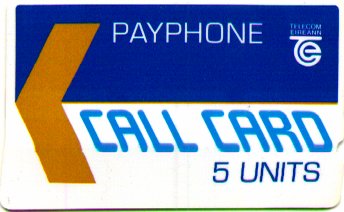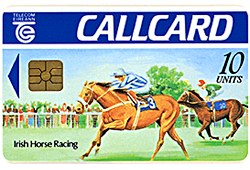After the card has been encoded the card is laminated with a sheet of transparent plastic on both sides. This stores the printed image and the data embedded into the card. Finally the notch is cut into the card so that blind people could insert the card the right way round.

The cards were available in 5, 10, 20, 50 and 100 unit denominations.
Dublin 5 Unit Card No: 1001
Developed by Autelca the Limerick trial cards are of the same design to cards used throughout the world. A total number of 31 phone-booths were installed throughout various part's of Limerick city and county for this trial.
Telecom also used the Autelca trial as means to sponsor the I.M.I. conference of 1989 by releasing two cards(20 and 50 unit card) to mark their involved with the institute.
The cards were available in 5, 10, 20, 50 and 100 unit denominations.

I.M.I. card of 1989.
Card No: 1019
Galway "Landis & Gyr Trial Cards."
These cards are the most secure of the three trials. How the card works is quite simple. An infra-red beam is passed along the track at the top of the card (usually located on the front of card). This creates a unique fingerprint. Once the card has been printed the optical track is embedded into the structure of the card and then covered with a thermo graphic layer.
There was a total of nine Landis & Gyr Phone-Booths installed throughout Galway city all of which are reported to have been destroyed after the trial ended.

Galway 20 Unit
The cards were available in 5, 10, 20, 50 and 100 unit denominations.
Card No: 1009
![]()
The Smart Card
They also realized at an early stage of each of the three trials that, certain individuals such as business men or tourists who traveled to different parts of the country were annoyed to find that they couldn't use a card that they had purchased in Limerick in Dublin due to the different trials taking place and vice versa.

An example of the Schlumberger Si7 Chipset
Hence the introduction of the Smart-Card, a light but versatile card no bigger or heavier than a standard credit card. The smart card was more expensive to develop but competition in the development was widespread and Telecom Eireann realized their early potential and even foreseen further enhancements to Callcards way back in the early 90's when they released the Dash card in Dublin. Today they trying out a similar trial with the Visa Cash Card Trial in Ennis in Co. Clare.
Most chip cards contain EPROM chips, which means that once the card has been programmed it cannot be recharged.

An Example of the Gemplus Gpt1 Chipset
Remote Memory Cards:
However as time has moved on and the cost of international calls has dropped dramatically the introduction of Remote memory cards was inevitable. When the first widely used card was introduced in 1994 nobody ever bothered much with them and many collectors seemed to pass them over. Now eight years on, and hundreds of different remote memory card companies later one may wonder are these the only cards we are ever going to find for our collections, as callcard releases have faded away to their cheaper counterpart and become impossible to obtain.
But to be truthful some remote memory card releases have been carefully designed to attract collectors and customers alike and are proving to be hard to obtain themselves. So keep your eyes open as you may just find a remote memory card that may take to your liking, you have been warned.
|
|
|
|
|
|
|
|
Examples of Some Remote memory cards: Swiftcall Dublin Zoo Releases.




